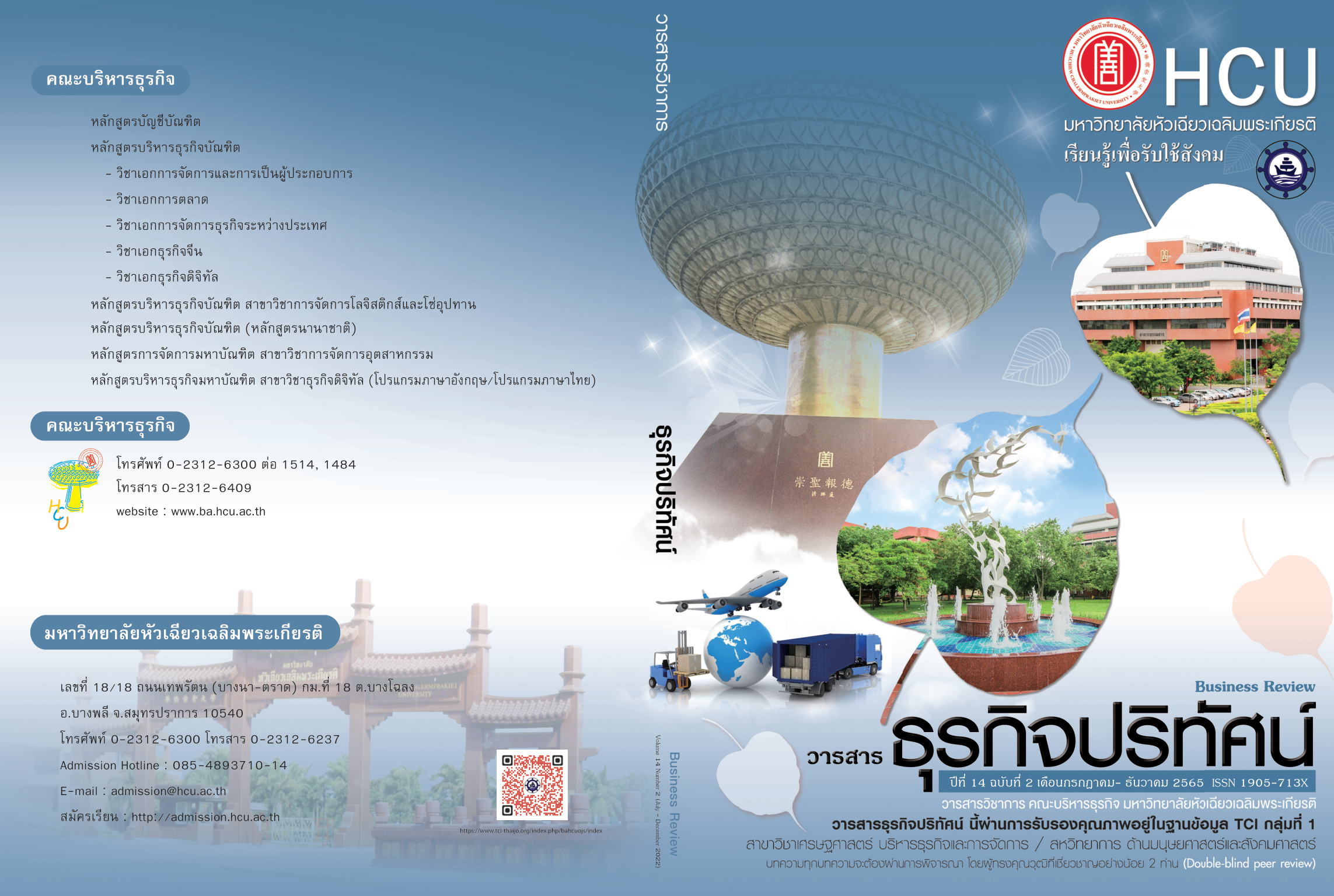The Relationship between Perceived Workload, Work Environment and Job Burnout of Employees in Banpho District Public Health Office, Chachoengsao Province.
Keywords:
Job burnout, Perceived workload, Work environmentAbstract
The objectives of this research were to study 1) Levels of Job burnout 2) To study job burnout classified by personal factors 3) To study the relationship between perceived workload, work environment and job burnout. The population in this research consisted of 73 employees in Banpho District Public Health Office, Chachoengsao Province and the instrument was questionnaire. Statistics for data analysis were percentage, mean, standard deviation and Pearson’s correlation analysis for hypothesis testing.
The result of this research revealed that 1) Populations had Job burnout in low level emotional Exhaustion in moderate level, and Depersonalization in very low level, and Lack of Personal Accomplishment in low level 2) Populations with different work experience levels have different job burnout 3) The hypothesis testing found perceived workload had related in the positive direction with job burnout at the significance level of 0.05 and work environment had related in the negative direction with job burnout at the significance level of 0.05
References
ธนากร ศรีโพธิ์กลาง. (2559). ความพึงพอใจต่อสภาพแวดล้อมในการทำงาน ความเหนื่อยหน่ายงานที่ส่งผลต่อความตั้งใจลาออกของพนักงานในบริษัทขนส่งสินค้าและบริการด้านโลจิสติกส์ชั้นนำ. วิทยานิพนธ์ธุรกิจมหาบัณฑิต, มหาวิทยาลัยเกษตรศาสตร์.
นฤมล กิจจานนท์, อัจฉรา จงเจริญกำโชค, พรพิมล มาศนรากรณ์. (2552). ความเหนื่อยหน่ายของบุคลากรพยาบาลในหอผู้ป่วยวิกฤติ. Rama Nurse Journal, 15(1), 86-97.
ลลิดา แท่งเพ็ชร. (2558). ความสัมพันธ์ระหว่างการรับรู้ภาระงาน สัมพันธภาพในการทำงานกับความเหนื่อยหน่ายในงานโดยมีการรับรู้ความสามารถของตนเองเป็นตัวแปรกำกับ. ศิลปศาสตรมหาบัณฑิต, มหาวิทยาลัยธรรมศาสตร์.
สสิพรรธน์ นิลสงวนเดชะ. (2558). ภาวะเหนื่อยหน่ายในการทำงานและกลวิธีในการเผชิญปัญหาของพนักงานองค์การเภสัชกรรม. วิทยานิพนธ์วิทยาศาสตร์มหาบัณฑิต, จุฬาลงกรณ์มหาวิทยาลัย.
สำนักนโยบายและยุทธศาสตร์กระทรวงสาธารณสุข. (2561). แผนยุทธศาสตร์ชาติระยะ 20 ปีด้านสาธารณสุข. สืบค้นเมื่อ 25 สิงหาคม 2563, เว็บไซต์: http://bps.moph.go.th.
อรสา ใจจินา. (2556). อิทธิพลของปัจจัยส่วนบุคคลและการสนับสนุนทางสังคมต่อความเหนื่อยหน่ายในการปฏิบัติงานของบุคลากรสาธารณสุขผู้รับผิดชอบงานสุขภาพจิตและจิตเวชในพื้นที่เครือข่ายบริการสุขภาพที่ 3. สารนิพนธ์ศึกษาศาสตร์มหาบัณฑิต, มหาวิทยาลัยศรีนครินทรวิโรฒ.
Bakker, A. B., Demoureti, E., Taris, T. W., Schaufeli, W. B., & Schreus, P. J. G. (2003). A multigroup analysis of the job demands-resources model in the four home care organizations. International Journal of Stress Management, 10, 16-38.
Cordes, C. L., & Dougherty, T. W. (1993). A review and integration of research on job burnout. Academy of Management Review, 18, 621–656.
Demerouti, E., Bakker, A. B., Nachreiner, F., & Schaufeli, W. B. (2001). The job demands – resources model of burnout. Journal of Applied Psychology, 86, 499–512.
Edelwich, J., & Brodsky. (1980). Burnout : Stages of disillusionment in the helping professions. New York: Human Sciences Press.
Gilmer VB. (1967). Applied Psychology. New York: McGraw-Hill Book.
Hart S., (2006). NASA-Task Load Index (TLX): 20 years later, Human Factors and Ergonomics Society Annual Meeting Proceedings, 50, 904-908.
Hobfoll, S. E. (2002). Social and psychological resources and adaptation. Review of General Psychology, 6, 43
Maslach, C. J. S. E. (1982). Burnout in the health professions: A social psychological analysis. In G. Sanders & J. Suls (Eds.), Hillsdale: NJ: Erlbaum, 227-251p.
Maslach, C., & Leiter, M.P. (2005). A mediation model of job burnout. In A. S. G. Antoniou & C. L. Cooper (Eds.), Research companion to organizational health psychology (pp. 544–564). Cheltenham. United Kingdom: Edward Elgar.
Maslach, C., & Leiter, M.P. (2007). Burnout. Elsevier Incorporated, 1, 368–371.
Maslach, C., & Jackson, S. E. (1986). Maslach burnout inventory. New York: Consulting Psychologists Press, 211-217.
Maslach, C., Schaufeli, W.B., and Leiter, M.P. (2001). Job burnout. Annual Reviews Psychology, 52, 397-422.
Moos, R.H. (1994). Work environment scale manual. (3rd ed). Palo Alto, CA: Consulting psychologists press.
Nwinyokpugi, P. (2018). Workload management strategies and employees efficiency in the Nigerian banking sector. International Journal of Innovative Research& Development, 7 (1), 286–293.
Downloads
Published
How to Cite
Issue
Section
License
Copyright (c) 2022 Business Review Journal

This work is licensed under a Creative Commons Attribution-NonCommercial-NoDerivatives 4.0 International License.
All articles published in the Business Administration and Management Journal Review are copyrighted by the journal.
The views and opinions expressed in each article are solely those of the individual authors and do not represent those of Huachiew Chalermprakiet University or any other faculty members. Each author is fully responsible for the content of their own article. Any errors or issues found are the sole responsibility of the respective author.




